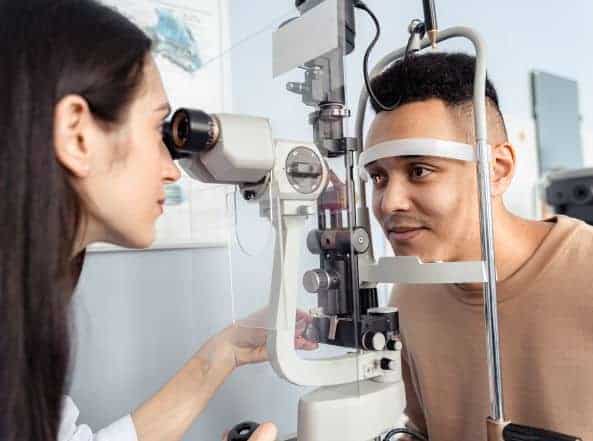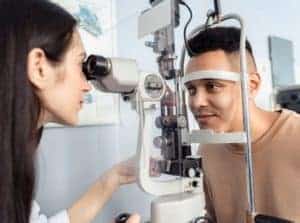
The Roles of an Optometrist, Ophthalmologist, & Optician
July 24, 2021

It can be tricky keeping track of all the “O-word” titles in the eye field. Optometrists, ophthalmologists, and opticians all co-manage vision and eye health to provide the most comprehensive care. Keep reading to learn more about the different roles of each type of eye care professional.
OPTOMETRIST

An optometrist is an eye doctor with a Doctor of Optometry (OD) degree that is obtained after a four-year undergraduate degree and four-year doctorate of optometry degree, in addition to passing the necessary board exams.
Optometrists perform a variety of exams and testing for different eye conditions.
– Provide routine eye exams for people of all ages
– Prescribe glasses
– Fit contact lenses in both children and adults
– Diagnose a wide variety of eye conditions
– Treat medical eye conditions, such as amblyopia, corneal abrasions, conjunctivitis, dry eye disease, uveitis, glaucoma
– Co-manage care after cataract and LASIK surgeries
– Manage patients with diabetes and those taking high-risk medications, such as hydroxychloroquine
– Assess low vision patients
– Perform and plan vision therapy programs
If it is determined that a patient would benefit from a particular surgery or procedure, an optometrist refers the patient to the appropriate specialist for further treatment. It is common for optometrists to co-manage, or share in the care, of these patients with ophthalmologists.
OPHTHALMOLOGIST

An ophthalmologist is an eye doctor with a Doctor of Medicine (MD) or Doctor of Osteopathy (DO) degree that is obtained after a four-year undergraduate degree, four years of medical school, a year of internship, and three years of residency. Some ophthalmology specialties require additional training.
The major difference in roles between an optometrist and ophthalmologist is that an ophthalmologist performs surgery. The following simplified list includes specialties and commonly performed surgeries within the subfield:
Specialties
Retina Specialist
A retina specialist performs surgeries to repair retinal holes, tears, and detachments. They treat wet macular degeneration and certain types of diabetic retinopathy with eye injections. Some conditions also require the use of a laser procedure.
Cornea Specialist
Cornea specialists perform refractive surgeries (such as LASIK), corneal transplants, cataract surgeries, and other minor laser procedures. Corneal cross-linking is a newer treatment for patients with keratoconus, and is completed by a cornea specialist.
Neuro-Ophthalmologist
This is one of the most specialized fields of ophthalmology and is closely related to neurology. Neuro-ophthalmologists manage and treat conditions involving the optic nerve, neurological issues, and visual pathway in the brain.
Pediatric Ophthalmologist
Congenital abnormalities, such as droopy eyelid, cataracts, and strabismus, are a few of the conditions that a pediatric ophthalmologist treats in young children. Some pediatric ophthalmologists will also perform strabismus surgery on adults too.
Oculoplastic Surgeon
An oculoplastic surgeon primarily focuses on the external structure of the eye and surrounding area. Blepharoplasty (lid lift) and removal of eyelid lesions are some of the more common procedures done in this specialty.
OPTICIAN

At Weber Vision Care, our opticians help you select the best type of lens and lens treatments for your daily needs. There are different progressive lens designs that optimize vision at various distances, in addition to lens treatments that provide anti-reflective properties and blue light protection. Our opticians also ensure that you choose a stylish frame that fits properly. A well-trained optician can match an individual’s face shape with a frame shape that enhances appearance.
The frame and lens selection mean nothing if the glasses do not sit on the face properly and the lenses are not measured accurately. It is very important to know where the pupil is located when looking through the glasses. This helps determine the optical center, or “sweet spot”, which is where the most precise prescription is located in the lens. If the frame is bent or damaged, it can alter which part of the lens is being utilized. If you are ever in need of a frame adjustment, one of our friendly opticians will happily help you.